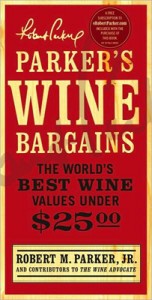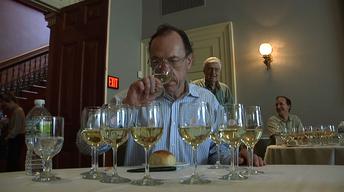 In the course of reading Robert M. Parker, Jr.’s new Parker’s Wine Bargains: The World’s Best Wine Values Under $25, I noticed a couple of strange things. First, I was surprised to find the same winery, Casa Lapostolle—one of Chile’s most prominent producers—listed in both the Argentina and Chile chapters of the book, which were each authored by Wine Advocate critic Jay Miller (who was recently criticized in the Wall Street Journal for accepting a lavish junket in Argentina, which was first exposed by Dr. Vino).
In the course of reading Robert M. Parker, Jr.’s new Parker’s Wine Bargains: The World’s Best Wine Values Under $25, I noticed a couple of strange things. First, I was surprised to find the same winery, Casa Lapostolle—one of Chile’s most prominent producers—listed in both the Argentina and Chile chapters of the book, which were each authored by Wine Advocate critic Jay Miller (who was recently criticized in the Wall Street Journal for accepting a lavish junket in Argentina, which was first exposed by Dr. Vino).
And in the index, there are two successive entries for the winery: “Casa Lapostolle (Argentina), 14; Casa Lapostolle (Chile), 84.”
I figured this was just an editing/database mistake. It happens.
But things got stranger when I actually compared the reviews of the exact same wines in the two chapters. Aside from the words “black currant” and “black fruits,” their descriptions turned out to be totally different from each other. Here they are:
(From Argentina chapter) “Casa Lapostolle Merlot Cuvée Alexandre Apalta Vineyard. This Merlot has an attractive nose of black currant, blueberry, vanilla, and clove. The wine has good weight on the palate with layers of black fruits and a firm structure. Drink it during its first 6 years of life.”
(From Chile chapter) “Casa Lapostolle Merlot Apalta Vineyard Cuvée Alexandre. The Merlot Apalta Vineyard Cuvée Alexandra [sic] has aromas of cedar, spice box, black cherry, and black currant followed by a smooth-textured, ripe Merlot with ample savory black fruits, good depth, and a moderately long finish.”
Blueberry, vanilla, and clove have been replaced by cedar, spice box, and black cherry. Is there a wine-adjective dartboard in the house?
Moving on to the second double…
(From Argentina chapter) “Casa Lapostolle Cabernet Sauvignon Cuvée Alexandre Apalta Vineyard. Similarly styled but with the focus on black currants. It has enough structure to evolve for 2–3 years in the bottle and will drink well during its first 8 years of life.”
(From Chile chapter) “Casa Lapostolle Cabernet Sauvignon Apalta Vineyard Cuvée Alexandre. The Cabernet Sauvignon Apalta Vineyard Cuvée Alexandre has an expressive bouquet of smoke, pencil lead, spice box, black cherry, and black currant. The wine’s black fruit flavors linger into a medium-long finish.”
At least the black currants travel well.
Mistakes like this do happen. They don’t discredit the critics behind them; we all have slightly different experiences when we taste the same wine twice. And in this case, although the tasting notes are totally different, they’re not quite mutually exclusive, nor do they render dramatically divergent judgments/opinions about the wine (Parker ratings are not included in the under-$25 book). But I see it as yet another reminder of the arbitrariness of these fruit/spice adjectives, even in the hands of the world’s highest-end wine critics—which is particularly troubling when these opinions turn out to be so powerful in the marketplace.




Thomas Pellechia
The problem with the fruit descriptors is that there are only so many to go around; critics seem to think that they must reach for the fruit words or no one will listen.
Now, if these people were trained to identify the chemistry, they might be able to come up with less fruity words and more wine-specific prose…
Robin Goldstein
Thomas: agreed. It was interesting to read Raffi Khatchadourian’s article about the flavor factory in the New Yorker food and wine issue a couple of weeks ago. The so-called “flavorists” can apparently pick out dozens of chemical compounds from, say, different types of citrus. But aromas are difficult. Khatchadourian writes:
“During a meeting with several flavor professionals in New Jersey, I compared a flavor chemist’s ability to break down the structure of a soft drink to the skills of Robert Parker, the wine critic. I was quickly corrected. ‘That’s kind of like hocus-pocus,’ one of them said. ‘Parker may say that a wine has a nutty note or is oaky, but a lot of things can be behind that, and I don’t think he’s matching aspects of the flavor to a chemical compound and going, ‘O.K. this note here, it comes from methyl isobutrate.” And yet controlled experiments show that, no matter what a person’s professional vocabulary or expertise, aromas remain a blur: the average person, with minimal training, can perceive about three or four distinct components in a given aroma; professional flavorists—without leaning on their chemical knowledge of particular types of food—can do no better.”
We shouldn’t be ashamed about the limitations of our own brains. We just have to keep in mind that these tasting notes are often works of creative fiction, and we should push for the use of more chemical analysis in wine aroma taxonomy. Analyzing the compounds that are in the headspace above a wine should yield more reproducible results than a critic (however great) sniffing it.
Thomas Pellechia
Robin,
I am re-reading Emile Peynaud, just to confirm that our attitude is not the crazy one.
As my years in the wine biz keep speeding by I keep being told by my own hubris that I know less rather than more…
Incidentally, the event last Wednesday truly was interesting. I will be blogging about it later today. You may disagree with some of my disagreements with your selections, but that’s how it always goes, isn’t it?
1WineDude
Wow, I find this fascinating.
Wow, I find this fascinating.
Wait, did I just say the same thing twice?…
Thomas Pellechia
Winedude,
Sometimes you have to say things twice so that others can get the joke…sometimes even more than twice.
Snag A Bargain
I think that is funny. Nice catch. But you are right, not everyone has the same experiences when tasting wine.